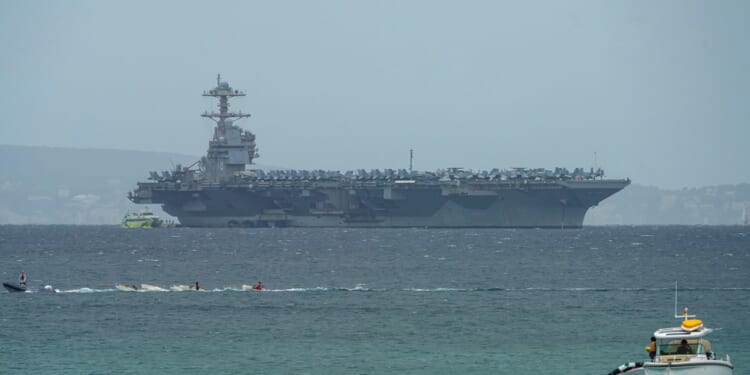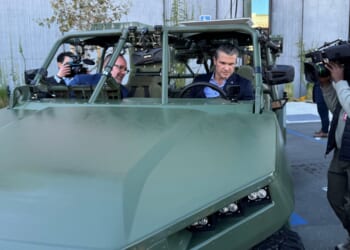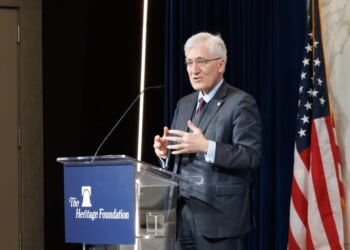Analysts have suggested that the US Navy’s Caribbean forces are insufficient to invade Venezuela. Instead, the show of force might be about persuading Venezuelan elites to overthrow Maduro themselves.
The United States Navy’s largest and most capable warship is steaming to the Caribbean, a significant escalation in President Donald Trump’s war on South American drug cartels. The USS Gerald R. Ford (CVN-78), the lead vessel of the newest class of nuclear-powered aircraft carrier, is leading a strike group that could potentially carry out strikes on cartel positions in Venezuela and Colombia.
The 100,000-ton supercarrier was operating in the Mediterranean, and there was speculation it might head to the Middle East, where the United States has maintained a significant presence for more than two years. However, earlier this month, USS Nimitz (CVN-68), the US Navy’s oldest nuclear-powered supercarrier, departed the region and was operating in the South China Sea.
These moves suggest a pivot in the United States’ strategy, with an emphasis on countering China’s aggression in the Indo-Pacific and battling drug cartels in Latin America.
The arrival of the Ford Carrier Strike Group will significantly increase the US Navy’s presence in the Caribbean, where there are already at least eight warships that include three destroyers, a cruiser, a littoral combat ship, an amphibious assault ship, and two transports, as well as a nuclear-powered submarine and United States Marine Corps F-35s operating from Puerto Rico. Over the past week, the United States Air Force has conducted patrol flights with three Boeing B-52 Stratofortress and two Rockwell B-1B Lancer bombers.
It is the largest US military show of force in the region since the 1960s.
The deployment of the CSG was meant to “bolster U.S. capacity to detect, monitor, and disrupt illicit actors and activities that compromise the safety and prosperity of the United States homeland and our security in the Western Hemisphere,” Pentagon spokesperson Sean Parnell wrote in a post on X.
The USS Gerald R. Ford’s Specifications
- Year Commissioned: 2017
- Length: 1,106 ft (337 m)
- Beam (Width): 256 ft (78 m)
- Displacement: ~100,000 long tons (112,000 t)
- Propulsion: Two Bechtel A1B PWR nuclear reactors; four propeller shafts
- Top Speed: ~30 knots (35 mph, 56 km/h)
- Range: Unlimited; approx. 25 years before nuclear refueling
- Armaments: Carries US Navy Carrier Air Wing Eight (eight squadrons), and
- Two RIM-162 ESSM launchers
- Two RIM-116 RAM launchers
- Three Phalanx CIWS systems
- Four Mk 38 25mm machine guns
- Four .50 caliber machine guns
- Crew: 4,539, including air wing
Is the Ford’s Deployment About Drugs—or Invasion?
The news of the deployment comes as the United States military sank at least the 10th boat purported to be carrying drugs from South America. The administration has repeatedly claimed that fast-moving speed boats are employed to bring drugs, including cocaine and fentanyl, into the United States.
Experts have suggested this isn’t actually the case.
“Fentanyl is primarily produced in Mexico—not South America—and comes into the US over the southern border,” the BBC reported. It added, “Venezuela does not produce large quantities of cocaine—that’s mainly Colombia, Peru and Bolivia.”
A United States Drug Enforcement Administration report from this year also found that 84 percent of cocaine seized in the United States had come from Colombia.
Although Trump has escalated the drug war to include boats coming from Colombia, experts have suggested this is about removing Venezuelan President Nicolás Maduro from power.
“This is about regime change. They’re probably not going to invade, the hope is this is about signaling,” Dr. Christopher Sabatini, a senior fellow for Latin America at the Chatham House think tank, told the BBC.
The overwhelming show of force is about forcing Venezuelan elites to oust Maduro.
“There are not enough assets for an invasion,” explained James B. Story in an interview with Politico.
Story served as the top diplomat to Venezuela during the first Trump administration and part of Biden’s administration. He explained that boots on the ground isn’t in the current plans, but there are now capabilities if that becomes necessary.
“There are enough ‘exquisite assets’ on site that could overwhelm the air defenses of the country, take out the Air Force, take out the navy, potentially decapitate the government if that were a decision that he decided to take,” Story added.
This “war” against “terrorist drug cartels” isn’t just about removing an unfriendly leader from power, but according to a report from The Telegraph newspaper, could be about curbing China’s growing influence in South America. Beijing has invested heavily in the South American country, so the case could be made that Trump is simply carrying out a 21st-century version of the Monroe Doctrine to keep potential adversaries out of America’s backyard.
“The deployment to the Caribbean is far beyond what you would need to conduct occasional strikes on vessels allegedly smuggling drugs,” explained Brian Finucane, a former State Department lawyer who is now senior adviser at the International Crisis Group.
Deploying B-52s, F-35s, and now a Carrier Strike Group may be the new version of gunboat diplomacy. Yet, President Theodore Roosevelt suggested the need to “Speak softly and carry a big stick,” whereas in this case, the US is shouting its intentions.
About the Author: Peter Suciu
Peter Suciu has contributed over 3,200 published pieces to more than four dozen magazines and websites over a 30-year career in journalism. He regularly writes about military hardware, firearms history, cybersecurity, politics, and international affairs. Peter is also a contributing writer for Forbes and Clearance Jobs. He is based in Michigan. You can follow him on Twitter: @PeterSuciu. You can email the author: [email protected].
Image Shutterstock / Roque Ramajo Polo.


















